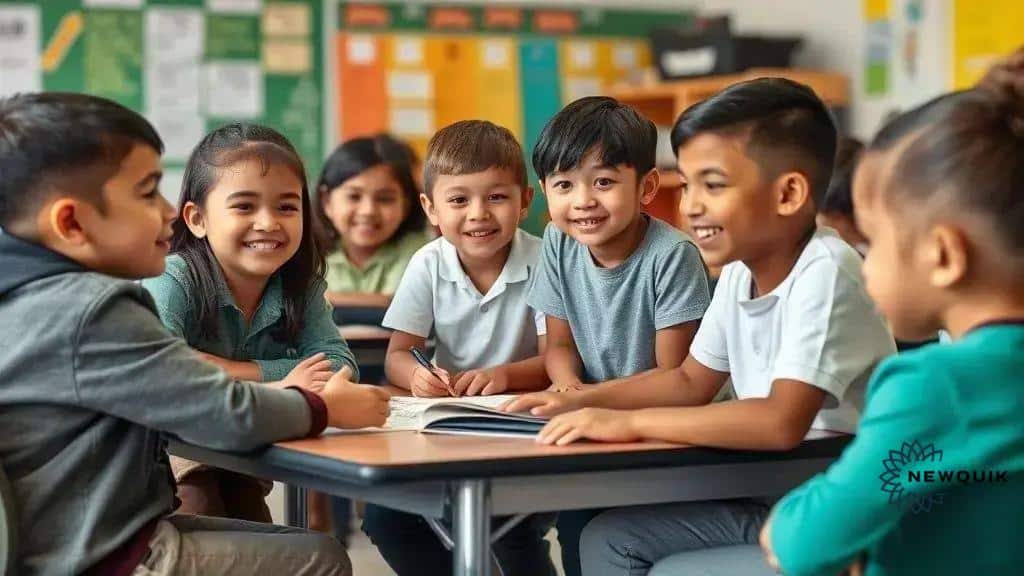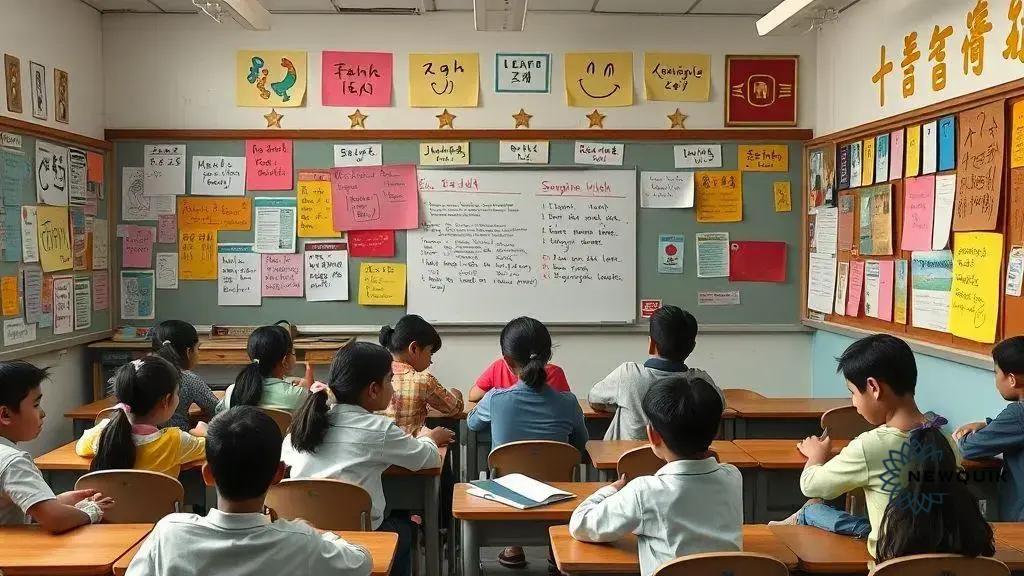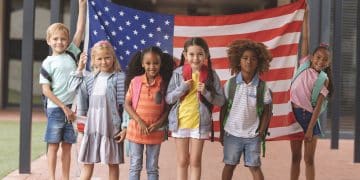Bilingual education in the US: unlocking brighter futures

Anúncios
Bilingual education in the US enhances language proficiency, boosts academic performance, and fosters cultural awareness, making it essential for preparing students for a diverse and interconnected world.
Bilingual education in the US offers unique opportunities for students, promoting not just language skills but also cultural enrichment. Have you noticed how being bilingual can open doors in today’s global job market? Let’s dive deeper.
Anúncios
What is bilingual education?
Bilingual education refers to a teaching approach where students are instructed in two languages. This method recognizes the value of cultural diversity and promotes academic excellence, enabling students to thrive in a globalized world. In bilingual classrooms, students benefit from learning in both their native language and the target language, allowing them to develop strong communication skills.
Understanding Bilingual Education
With bilingual education, students learn core subjects like mathematics, science, and literature in both languages. This immersive experience helps them grasp complex concepts while enhancing their language proficiency.
Types of Bilingual Education Programs
There are several types of bilingual education programs:
Anúncios
- Transitional Bilingual Education: This approach supports students with limited English proficiency, gradually transitioning them to English instruction.
- Maintenance Bilingual Education: Students continue to learn in both languages throughout their education, preserving their native language.
- Dual Language Programs: These programs serve both native English speakers and native speakers of another language, promoting bilingualism and biliteracy.
Through these diverse programs, students gain not only language skills but also confidence and cultural awareness. Research shows that bilingual education can lead to better cognitive development, improved academic performance, and expanded career opportunities in the future. Moreover, it enhances cross-cultural understanding and promotes inclusivity within schools and communities. As we explore the realm of bilingual education, it’s essential to consider how it can enrich the lives of students and prepare them for a diverse world.
Benefits of bilingual education for children
Engaging in bilingual education provides numerous advantages for children. Not only does it foster language skills, but it also enhances cognitive abilities. Children exposed to more than one language develop better problem-solving skills and greater creativity, helping them navigate complex tasks with ease.
Improved Academic Performance
Research indicates that children in bilingual education programs tend to outperform their peers in standardized tests. This success stems from their ability to think critically and analyze information from multiple perspectives. Being adept in two languages allows them to grasp concepts more thoroughly.
Cultural Awareness
Through bilingual education, children gain valuable insights into different cultures. This exposure not only promotes understanding but also fosters empathy towards others. Such experiences are crucial in our increasingly interconnected world, preparing children to thrive in diverse environments.
- Enhanced communication skills
- Stronger connections with peers from different backgrounds
- Increased adaptability to new situations
Moreover, bilingual children often show resilience when facing challenges. Their ability to switch between languages and perspectives enables them to approach problems creatively. They also enjoy the privilege of better employment opportunities later in life, as many employers value bilingualism highly.
In a global job market, being bilingual can set a candidate apart. The benefits of bilingual education extend far beyond academic achievements, shaping well-rounded individuals ready to face the future with confidence.
Challenges faced in bilingual education programs

Bilingual education programs face various challenges that can impact their effectiveness. These challenges often stem from differing linguistic backgrounds, teaching resources, and community support. Understanding these hurdles is essential for improving programs and ensuring that all students benefit from bilingual education.
Linguistic Diversity
A primary challenge in bilingual education is the linguistic diversity of students. Each child may have a different native language, making it difficult for teachers to address individual needs. In classrooms, varying levels of proficiency in both languages can mean that some students lag behind.
Resource Availability
Another significant issue is the availability of resources. Many schools lack the proper materials and trained staff to provide effective bilingual education. For instance, textbooks and learning tools may only be available in one language, limiting students’ access to vital information.
- Inadequate training for teachers
- Lack of funding for bilingual programs
- Insufficient support from educational authorities
In addition, parents and communities might not fully understand the goals and benefits of bilingual education. Without strong support systems, educators can struggle to maintain momentum and encourage family involvement in their children’s learning. As a result, students may not receive the encouragement they need to excel in both languages.
Furthermore, standardized testing can be a hurdle, as assessments often focus on English language proficiency, putting bilingual students at a disadvantage. This situation can lead to low confidence and motivation among learners.
Cultural impacts of bilingual education
Cultural impacts of bilingual education are profound and far-reaching. These programs help to bridge cultural divides by promoting understanding and respect among diverse groups. When students learn in a bilingual environment, they do not just acquire language skills; they also gain insights into different ways of life and traditions.
Enhanced Cultural Competence
Participating in bilingual education enables students to develop cultural competence. They learn to appreciate other cultures while also valuing their own. This duality fosters a sense of identity and belonging that can enhance a child’s self-esteem.
Community Engagement
Bilingual education also encourages greater community engagement. Families that are engaged in their children’s education help to create a supportive network. Schools that embrace bilingual programs often involve community members in activities and events, fostering a stronger sense of community.
- Encouraging cross-cultural friendships
- Inviting parents to share their cultural traditions
- Promoting cultural events and celebrations
Additionally, students with exposure to multiple cultures often display increased empathy. They become aware of global issues and learn to approach them from various perspectives. This awareness is crucial in today’s interconnected world, where understanding and collaboration are vital for success.
As students embrace different cultural practices, they contribute to a more inclusive society. The skills learned in bilingual education programs pave the way for future leaders who respect diversity and advocate for multiculturalism. The long-term effects of these cultural impacts can transform entire communities, making them more resilient and harmonious.
The future of bilingual education in the US
The future of bilingual education in the US looks promising as more schools recognize its benefits. With the growing diversity in classrooms, the need for effective bilingual programs is becoming clearer. These programs not only support language acquisition but also foster cultural understanding, making them essential in today’s educational landscape.
Increased Awareness and Support
As awareness of the advantages of bilingual education continues to rise, more parents and educators advocate for these programs. Schools are increasingly integrating bilingual curricula to meet the needs of English language learners. This shift is supported by research that shows students benefit academically and socially from bilingual instruction.
Policy Changes
Future changes in educational policy will likely play a significant role in shaping bilingual education. Governments at local and state levels are starting to implement policies that promote bilingual programs. These initiatives can lead to improved funding, better training for teachers, and enhanced resources for schools.
- Increased funding for bilingual programs
- Development of high-quality bilingual teaching materials
- More professional development opportunities for educators
Technology also plays a pivotal role in the evolution of bilingual education. Online resources and language learning apps offer students additional tools to practice their skills outside of the classroom. This technology enhances traditional methods of language instruction, making learning more interactive and engaging.
As the job market demands more bilingual professionals, schools will likely focus on equipping students with the skills they need to succeed globally. Emphasizing bilingual education prepares students for future careers in an increasingly interconnected world. The combination of community support, policy advancements, and technological innovation can transform the landscape of bilingual education, providing students with the skills they need for lifelong success.
In conclusion, the future of bilingual education in the US is set to grow as communities and schools recognize its importance. With increasing support, government policies, and the integration of technology, these programs can effectively meet the needs of diverse student populations. Bilingual education not only enhances language skills but also fosters cultural understanding, preparing students for success in a globalized world. As awareness continues to spread, we can anticipate a stronger emphasis on bilingual programs, benefiting both students and society as a whole.
FAQ – Frequently Asked Questions About Bilingual Education in the US
What are the main benefits of bilingual education?
Bilingual education enhances language skills, improves academic performance, and fosters cultural understanding among students.
How does bilingual education impact cultural awareness?
It promotes empathy and appreciation for different cultures, enabling students to connect with a diverse range of perspectives.
What challenges do bilingual education programs face?
Challenges include linguistic diversity among students, resource availability, and the need for professional training for teachers.
What is the future of bilingual education?
The future looks promising, with increased support, better resources, and a focus on preparing students for global careers.





